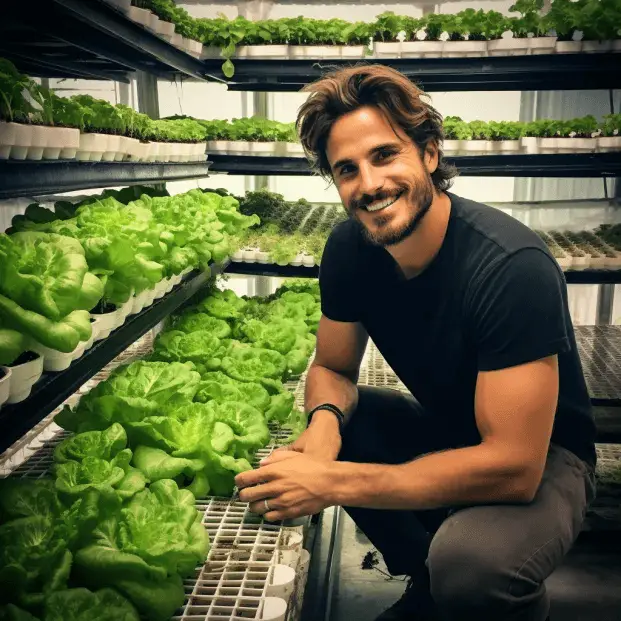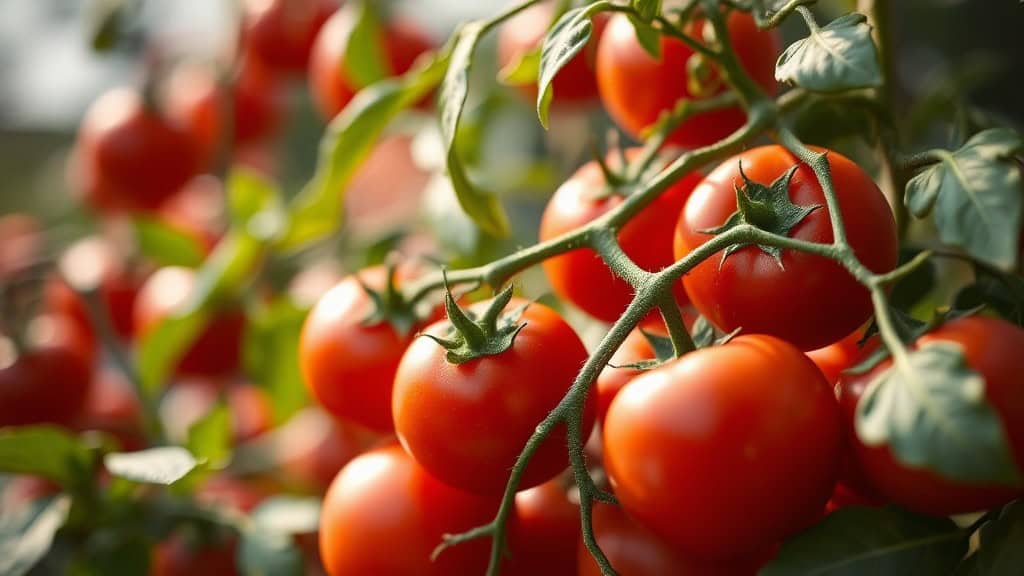Tomatoes thrive when they get the right light intensity—it’s like fuel for their growth. Too little light makes them leggy, while too much can stress them out. Aim for a Daily Light Integral (DLI) of at least 5 mol/m²/day to keep them sturdy, and around 10 mol/m²/day for bigger, healthier fruit. (1)
Younger plants should be closer to the lights, while mature ones can handle a bit more distance. Finding the sweet spot ensures strong growth and better yields. Want to grow vibrant, fruit-filled plants? Keep reading to learn how to perfect your tomato lighting setup!
Key Takeaway
- Tomatoes grow best with a light intensity of about 240 μmol m-2s-1.
- Too little light makes plants weak, and too much light can hurt their growth.
- The right balance of red and blue light helps tomatoes grow strong and healthy.
Understanding Light Intensity for Tomatoes
Credits: Alex Grows Food
Watching tomato plants grow feels a bit like watching a tiny miracle unfold. There’s something special about seeing those little green stems stretch toward the light. But tomatoes don’t just grow for the sake of it—they need the right amount of light to stay strong and healthy.
Without enough, they stretch too much, a process called etiolation. It’s like a kid reaching for a toy on a high shelf—sure, they might reach it, but they’re wobbly and unsteady without proper support. That’s what happens to tomatoes when they’re starved for light.
Too much light, though, can be just as harmful. It’s like spending hours in the sun without sunscreen—leaves can scorch, turning yellow or brown. Tomatoes thrive with about 6 to 8 hours of sunlight daily, a balance that keeps them happy and growing.
For indoor growers, grow lights are a game-changer. LEDs, in particular, are a great option—they provide the right intensity without overheating the plants. With the right setup, anyone can create the perfect environment for their tomatoes to flourish.
Finding the Right Balance
Getting the right balance of light for tomatoes can feel like a bit of a guessing game. Too little light, and the plants grow tall and spindly, weak and struggling. Too much, and the leaves can scorch, curling or turning brown. Tomatoes seem happiest with light that’s bright but not overwhelming, like a sunny morning before the heat kicks in.
The writer recalls their first attempt at growing tomatoes. They picked the sunniest spot, thinking more light meant better growth. But after a few weeks, the leaves started curling at the edges. That’s when they learned tomatoes prefer a break from direct sunlight during the hottest hours—it’s like giving them shade to cool off.
Here are a few practical tips for finding the sweet spot with light intensity:
Check the Leaves: Healthy, green leaves mean the light is just right. If they start yellowing or browning, it’s probably too much. Rotate the Plants: If they’re leaning toward the light, give them a turn every few days to keep growth even.
Use a Light Meter: A simple tool to measure light intensity. Aim for 200 to 400 µmol/m²/s, which is ideal for tomatoes. Balancing light takes some trial and error, but once it’s right, tomatoes grow stronger and healthier. It’s all about paying attention to what the plants are telling you.
The Best Light Levels for Your Tomatoes
The grow lights flickered faintly as the writer sat down to check on their tomato plants. Something about the green leaves, almost glowing under the soft hum of LEDs, made them think about light levels. It’s not just about having enough light—it’s about getting it right.
Tomato seedlings seem to thrive at around 240 μmol/m²/s. It’s not a magic number, but close enough (and probably the “just right” Goldilocks range). Here’s the sweet spot for most stages:
- Seedlings: ~240 μmol/m²/s
- Mature plants: Between 250–330 μmol/m²/s
Too much light can scorch leaves; too little makes them spindly. Once, they cranked the intensity up, thinking more was better. Instead, the plants rebelled—yellowing leaves and curling tips. Lesson learned.
For balance, keep a light meter handy (even a cheap one helps). Watch how the plants react. Adjust as needed. Gardening isn’t about perfection—it’s about small tweaks.
What Happens with Too Little or Too Much Light?
The writer stared at a tomato plant stretching toward a dim grow light. It was spindly, with thin stems swaying like it had somewhere to be but no strength to get there. That’s what happens under 60 μmol/m²/s. The leaves turn pale, growth slows, and the plant looks lost.
Too much light’s no better. Cranking past 330 μmol/m²/s can scorch leaves and stunt growth (like overfeeding a pet; they can’t handle it).
Signs of trouble:
- Too little light: Stretching stems, pale leaves, sluggish growth.
- Too much light: Curling edges, brown spots, stunted size.
Balance is key. They once overdid it, and the leaves crisped. Backed off, and the plant bounced back. Watching light levels with a simple meter can help. Keep checking. Plants tell you what they need if you’re paying attention.
Why Light Quality Matters
A tomato plant basking under just the right light is a sight—leaves glossy, stems strong. But the kind of light matters. Red light (at 660 nm) helps flowers bloom and fruit ripen. Blue light (around 450 nm)? That’s for lush, green leaves.
One summer, a grow light switch made all the difference. A struggling plant with pale leaves transformed overnight. The new light (7 parts red to 3 parts blue) seemed like magic. Soon enough, the plant burst with fruit, each one better than the last.
Light tips for tomatoes:
- Red light: Promotes flowering.
- Blue light: Strengthens leaves.
- Mixed spectrum: Ensures balanced growth.
Nighttime lighting’s useful too—sparingly. A friend’s LEDs, on for just two hours past sunset, made their tomatoes sweeter and larger. But too much light? Leaves droop. So, adjust, test, and watch the plants. They’ll tell you when it’s just right.
Tips for Growing Great Tomatoes
A tomato plant under a glow of LED light—it’s like watching magic. LEDs (those energy-efficient bulbs) are a gardener’s secret weapon. They sip power, stay cool, and deliver the perfect red-blue mix tomatoes crave. (2)
Years ago, swapping regular bulbs for LEDs turned my garden around. My plants were sluggish—barely growing. But under LEDs? Leaves thickened, stems straightened, and fruit seemed to appear overnight.
Why LEDs work so well:
- Energy savers: Lower bills, longer life.
- Cool glow: Won’t scorch leaves.
- Custom light spectrum: Just enough red and blue (7:3 ratio).
Tomatoes also love the right PPFD (light intensity). Around 240 μmol/m²/s keeps them thriving. I learned this the hard way—guessing and hoping until a $20 light meter fixed it.
If your plants feel “meh,” check the lights. Adjust. Test. Repeat. Sometimes, it’s just about finding their sweet spot.
Conclusion
A tomato plant under just the right light grows like it’s telling you a secret. Not too dim, not too bright—about 240 μmol m-2s-1 seems to be their sweet spot. It’s a balance.
He remembered when his plants looked tired, almost sulking. Then came the light meter (a cheap gadget, really). With a few tweaks, the leaves perked up, and the fruits followed suit.
For tomatoes:
- Light intensity matters.
- Keep it steady.
- Measure often.
Every plant’s a little different, though. So, check your setup, make adjustments, and watch your garden thrive. Sometimes, small changes mean everything.
FAQ
How much light intensity do tomatoes need?
Tomatoes need moderate to high light intensity for healthy growth. Generally, they thrive with 400 to 700 micromoles per square meter per second (µmol/m²/s) of light intensity, which mimics natural sunlight. This ensures they get enough energy for photosynthesis. If the light is too weak, tomatoes may grow leggy or produce fewer fruits. Too strong, and it can scorch the leaves.
Can I use low-intensity lights for growing tomatoes?
Low-intensity lights can work for seedlings or early growth stages, but they’re not ideal for mature plants. Tomatoes need stronger light during flowering and fruiting to produce high yields. If you’re using low-intensity lights, you may need to keep them closer to the plants and supplement with additional lighting to meet their needs.
How do I measure light intensity for tomatoes?
You can use a light meter or a PAR meter to measure light intensity. These tools help determine how much usable light your plants are getting in micromoles per square meter per second (µmol/m²/s). For a simpler option, you can use a smartphone app designed to estimate light levels, though these may not be as precise.
What happens if the light intensity is too low?
When light intensity is too low, tomatoes may grow slowly, develop pale or yellow leaves, and produce fewer or smaller fruits. They might also stretch toward the light, becoming leggy and weak. Low intensity can also delay flowering and reduce the plant’s overall health.
Can too much light intensity harm tomatoes?
Yes, excessive light intensity can stress tomato plants. Signs include scorched leaves, wilting, or heat damage. To avoid this, monitor how your plants respond and adjust the light’s distance or intensity settings. Most grow lights allow you to dim the output or move the lights further away from the plants.
Is natural sunlight better than artificial light for tomatoes?
Natural sunlight is ideal because it provides full-spectrum light at high intensity, but it’s not always available or consistent. Artificial grow lights let you control intensity and duration, ensuring tomatoes get the light they need year-round. Both methods work, but grow lights can fill gaps when sunlight isn’t enough.
How close should grow lights be to tomato plants?
The distance depends on the type and intensity of the light. High-intensity lights like LEDs should be 12–24 inches away from the plant canopy to avoid burning. Lower-intensity lights, like fluorescents, can be closer, around 6–12 inches. Adjust based on how the plants respond.
Should light intensity change during the tomato growth stages?
Yes, tomatoes need different light intensities as they grow. Seedlings require lower intensity to avoid stress, while flowering and fruiting stages need higher intensity for maximum yield. Adjust your light settings or move the lights as the plants grow to match their needs.
References
- https://pmc.ncbi.nlm.nih.gov/articles/PMC10686476/
- https://www.batagrowlight.com/greenhouse-supplemental-lighting/
Related Articles
- https://tophydroponicgarden.com/best-hydroponic-grow-lights/
- https://tophydroponicgarden.com/tomatoes/
- https://tophydroponicgarden.com/choosing-plant-species-for-aeroponics/
Was this helpful?

I’m Barrie L., a passionate hydroponic gardening enthusiast dedicated to cultivating thriving, soil-less gardens. With a focus on all things hydroponic, I share my expertise on innovative growing techniques and sustainable practices through my blog, tophydroponicgarden.com. As a seasoned hydroponics specialist, my goal is to inspire and guide fellow gardeners in harnessing the power of water-based cultivation for bountiful and eco-friendly harvests. I’m also an author of the book “Hydroponics For Absolute Beginners: Your Step By Step Guide For How To Create An Hydroponics System At Home Without Soil, For Growing Vegetable, Fruit And Herbs.” which is sold on Amazon. Join me on a journey of redefining the way we cultivate plants, one nutrient-rich solution at a time. Happy growing!


